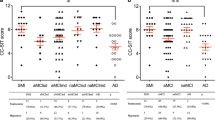Abstract
Performance in olfactory identification was studied in mild cognitive impairment (MCI), using slightly expanded standard clinical approach to study the olfactory nerve. Four hundred and eighty-six cognitively normal individuals and 72 individuals with MCI underwent spontaneous and cued odor identification and delayed odor recall. Performance in these was compared with the performance in the CERAD version of the Boston Naming Test (BNT). The individuals with MCI scores significantly worse in all tests compared with controls, but the performance in tests assessing odor were less impaired than performance in the BNT. Standard assessment of olfactory nerve function is not sufficient to study cognitive impairment in MCI.
Similar content being viewed by others
Abbreviations
- AD:
-
Alzheimer’s disease
- BNT:
-
Boston Naming Test
- CC-SIT:
-
Cross-cultural smell identification test
- CDR:
-
Clinical dementia rating
- CERAD:
-
Consortíum to establish a registry for Alzheimer’s disease
- DSM-IV:
-
Diagnostic and statistical manual of mental disorders, fourth edition
- MCI:
-
Mild cognitive impairment
- MMSE:
-
Mini-mental state examination
- UPSIT:
-
University of Pennsylvania smell identification test
References
Devanand DP, Michaels-Marston KS, Liu X, Pelton GH, Padilla M, Marder K, Bell K, Stern Y, Mayeux R (2000) Olfactory deficits in patients with mild cognitive impairment predict Alzheimer’s disease at follow-up. Am J Psychiatry 157:1399–1405
Doty RL, Shaman P, Kimmelman CP, Dann MS (1984) University of Pennsylvania Smell Identification Test: a rapid quantitative olfactory function test for the clinic. Laryngoscope 94:176–178
Doty RL, Marcus A, Lee WW (1996) Development of the 12-item Cross-Cultural Smell Identification Test (CC-SIT). Laryngoscope 106:353–356
Gray AJ, Staples V, Murren K, Dhariwal A, Bentham P (2001) Olfactory identification is impaired in clinic-based patients with vascular dementia and senile dementia of Alzheimer type. Int J Geriatr Psychiatry 16:513–517
Lange R, Donathan CL, Hughes LF (2002) Assessing olfactory abilities with the University of Pennsylvania smell identification test: a Rasch scaling approach. J Alzheimer Dis 4:77–91
Lorig TS (1999) On the similarity of odor and language perception. Neurosci Biobehav Sci 23:391–398
McCaffrey RJ, Duff K, Solomon GS (2000) Olfactory dysfunction discriminates probable Alzheimer’s disease from major depression: a cross-validation and extension. J Neuropsychiatry Clin Neurosci 12:29–33
Moberg PJ, Doty RL, Mahr RN, Mesholam RI, Arnold SE, Turetsky BI, Gur RE (1997) Olfactory identification in elderly schizophrenia and Alzheimer’s disease. Neurobiol Aging 18:163–167
Morris JC, Heyman A, Mohs RC, Huhges JP, van Belle G, Fillenbaum G, Mellits ED, Clarck C (1989) The Consortium to Establish a Registry for Alzheimer’s Disease (CERAD). Part I. Clinical and neuropsychological assessment of Alzheimer’s disease. Neurology 39:1159–1165
Murphy C, Schubert CR, Cruickshanks KJ, Klein BEK, Klein R, Nondahl DM (2002) Prevalence of olfactory impairment in older adults. JAMA 288:2307–2312
Petersen RC, Stevens JC, Ganguli M, Tangalos EG, Cummings JL, DeKosky ST (2001) Practice parameter. Early detection of dementia: mild cognitive impairment (an evidence-based review). Report of the Quality Standards Subcommittee of the American Academy of Neurology. Neurology 56:1133–1142
Royall DR, Chiodo LK, Polk MS, Jaramillo CJ (2002) Severe dysosmia is specifically associated with Alzheimer-like memory deficits in nondemented elderly retirees. Neuroepidemiology 21:68–73
Swan GE, Carmelli D (2002) Impaired olfaction predicts cognitive decline in nondemented older adults. Neuroepidemiology 21:58–67
Tabert MH, Liu X, Doty RL, Serby M, Zamora D, Pelton GH, Marder K, Alberts MW, Stern Y, Devanand DP (2005) A 10-item smell identification scale related to risk for Alzheimer’s disease. Ann Neurol 58:155–160
Tervo S, Kivipelto M, Hänninen T, Vanhanen M, Hallikainen M, Mannermaa A, Soininen H (2004) Incidence and risk factors for mild cognitive impairment: a population-based three-year follow-up study of cognitively healthy subjects. Dement Geriatr Cogn Disord 17:196–203
Thompson MD, Knee K, Golden CJ (1998) Olfaction in persons with Alzheimer’s disease. Neuropsychol Rev 8:1–23
Wang QS, Tian L, Huang YL, Qin S, He LQ, Zhou JN (2002) Olfactory identification and apolipoprotein E ε4 allele in mild cognitive impairment. Brain Res 951:77–81
Westervelt HJ, Ruffolo JS, Tremont G (2005) Assessing olfaction in the neuropsychological exam: the relationship between odor identification and cognition in older adults. Arch Clin Neuropsychol 20:761–769
Acknowledgments
The study was supported by the Aging Program of the Academy of Finland (48138), EVO grant of Kuopio University Hospital (5772720), and the Sigrid Jusélius Foundation.
Author information
Authors and Affiliations
Corresponding author
Rights and permissions
About this article
Cite this article
Laakso, M.P., Tervo, S., Hänninen, T. et al. Olfactory identification in non-demented elderly population and in mild cognitive impairment: a comparison of performance in clinical odor identification versus Boston Naming Test. J Neural Transm 116, 891–895 (2009). https://doi.org/10.1007/s00702-009-0235-8
Received:
Accepted:
Published:
Issue Date:
DOI: https://doi.org/10.1007/s00702-009-0235-8




